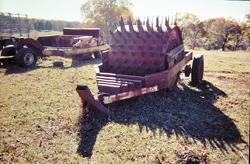
They do it to golf courses, lawns and ball fields. So why not aerate pastures? Charles Golden does, and he swears by it. His homemade aerator drives its blades 8 in. deep.
"It just stirs the ground a little," says Golden. "The hole isn't big enough to cause problems for cattle, but when you're done in the fall, the rain really softens the ground. It soaks right in."
His aerator is massive, with a drum 5 ft. long and 5 ft. in diameter and made of 1-in. thick steel. Originally a self-propelled road packer, it was being junked when Golden ran across it. The motorized portion of the frame had been cut away though most of the 12-in. steel beam frame remained. He rebuilt the frame, reinforcing it and bringing it to a point in front.
Golden knew he would have to be able to raise the aerator on turns or it would chew up the sod. To do so, he fashioned 3-pt. hitch adapters that hook to the frame hitch to lift the roller off the ground.
"The 3-pt. hitch lets me pick it up just enough with my Deere 4240 to clear the ground on turns," says Golden.
The axle is an old truck front axle that lets the aerator trail the 3-pt. in the raised position. Golden attached it to the frame of the aerator drum with a piece of 4 by 7-in. box beam. One end of the beam is welded to either side of the axle housing. The other end slides through a channel welded to the center rear of the aerator frame. Holes drilled in the channel and the box beam let Golden adjust the wheels down for travel or out of the way for aeration.
"I pick it up with the 3-pt. hitch, loosen the pins and set the wheels," explains Golden. "I could have used hydraulics, but this was simpler."
The teeth are 8 in. long, and 4 in. wide at the base and taper to a point. They were cut form 3/4-in. steel plate and welded in place at an angle on 8-in. centers. Initially Golden had rows of teeth every 4 in., but discovered they cut the ground up too much. The 8-in. spacing provides optimum aeration.
He stacks old railroad rails on the front of the frame.
"The extra weight pushes the tongue down and keeps the aerator in the ground," says Golden. "It's a mean machine, and it rolls pretty fast on flat ground. I've covered every acre twice since I built it. With the drought we've had, I need to keep using it so rains will soak in when they do come."
